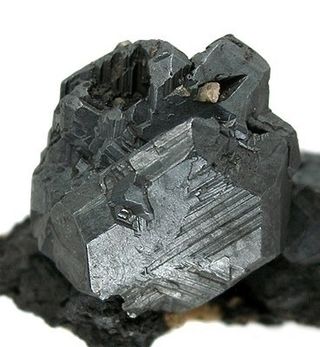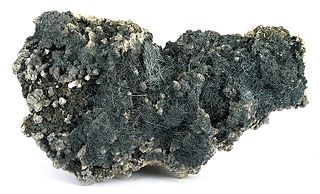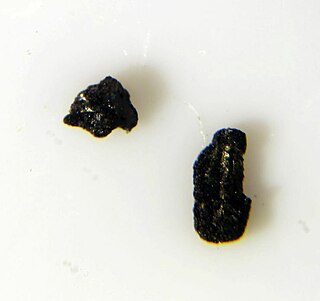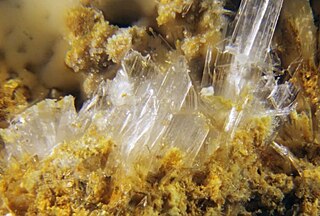
Chalcopyrite ( KAL-kə-PY-ryte, -koh-) is a copper iron sulfide mineral and the most abundant copper ore mineral. It has the chemical formula CuFeS2 and crystallizes in the tetragonal system. It has a brassy to golden yellow color and a hardness of 3.5 to 4 on the Mohs scale. Its streak is diagnostic as green-tinged black.

Sphalerite is a sulfide mineral with the chemical formula (Zn,Fe)S. It is the most important ore of zinc. Sphalerite is found in a variety of deposit types, but it is primarily in sedimentary exhalative, Mississippi-Valley type, and volcanogenic massive sulfide deposits. It is found in association with galena, chalcopyrite, pyrite, calcite, dolomite, quartz, rhodochrosite, and fluorite.

Greenockite is a rare cadmium bearing metal sulfide mineral consisting of cadmium sulfide (CdS) in crystalline form. Greenockite crystallizes in the hexagonal system. It occurs as massive encrustations and as hemimorphic six-sided pyramidal crystals which vary in color from a honey yellow through shades of red to brown. The Mohs hardness is 3 to 3.5 and the specific gravity is 4.8 to 4.9.

Acanthite is a form of silver sulfide with the chemical formula Ag2S. It crystallizes in the monoclinic system and is the stable form of silver sulfide below 173 °C (343 °F). Argentite is the stable form above that temperature. As argentite cools below that temperature its cubic form is distorted to the monoclinic form of acanthite. Below 173 °C acanthite forms directly. Acanthite is the only stable form in normal air temperature.

Chalcocite, copper(I) sulfide (Cu2S), is an important copper ore mineral. It is opaque and dark gray to black, with a metallic luster. It has a hardness of 2.5–3 on the Mohs scale. It is a sulfide with a monoclinic crystal system.

Wurtzite is a zinc and iron sulfide mineral with the chemical formula (Zn,Fe)S, a less frequently encountered structural polymorph form of sphalerite. The iron content is variable up to eight percent. It is trimorphous with matraite and sphalerite.

Cobaltite is a sulfide mineral composed of cobalt, arsenic, and sulfur, CoAsS. Its impurities may contain up to 10% iron and variable amounts of nickel. Structurally, it resembles pyrite (FeS2) with one of the sulfur atoms replaced by an arsenic atom.

Hardystonite is a rare calcium zinc silicate mineral first described from the Franklin, New Jersey, U.S. zinc deposits. It often contains lead, which was detrimental to the zinc smelting process, so it was not a useful ore mineral. Like many of the famous Franklin minerals, hardystonite responds to short wave ultraviolet light, emitting a fluorescence from dark purple to bright violet blue. In daylight, it is white to gray to light pink in color, sometimes with a vitreous or greasy luster. It is very rarely found as well formed crystals, and these are usually rectangular in appearance and rock-locked.

Stannite is a mineral, a sulfide of copper, iron, and tin, in the category of thiostannates.

Gahnite, ZnAl2O4, is a rare mineral belonging to the spinel group. It forms octahedral crystals which may be green, blue, yellow, brown or grey. It often forms as an alteration product of sphalerite in altered massive sulphide deposits such as at Broken Hill, Australia. Other occurrences include Falun, Sweden where it is found in pegmatites and skarns; and, in the United States, Charlemont, Massachusetts; Spruce Pine, North Carolina; White Picacho district, Arizona; Topsham, Maine; and Franklin, New Jersey.

Boulangerite is an uncommon monoclinic orthorhombic sulfosalt mineral, lead antimony sulfide, formula Pb5Sb4S11. It was named in 1837 in honor of French mining engineer Charles Boulanger (1810–1849), and had been a valid species since pre-IMA. It was first described prior to 1959, and is now grandfathered.

Franckeite, chemical formula Pb5Sn3Sb2S14, belongs to a family of complex sulfide minerals. Franckeite is a sulfosalt. It is closely related to cylindrite.

Stilleite is a selenide mineral, zinc selenide, with the formula ZnSe. It has been found only as microscopic gray crystals occurring as inclusions in linnaeite associated with other selenide and sulfides. It was originally discovered in Katanga Province, Zaire in 1956 and is named for the German geologist, Hans Stille (1876–1966).
Argutite (GeO2) is a rare germanium oxide mineral. It is a member of the rutile group.

Gunningite is one of the minerals in the Kieserite group, with the chemical formula (Zn,Mn2+)SO4·H2O. Its name honours Henry Cecil Gunning (1901–1991) of the Geological Survey of Canada and a professor at the University of British Columbia.

Renierite is a rare copper zinc germanium bearing sulfide mineral with the chemical formula (Cu,Zn)11(Ge,As)2Fe4S16. It occurs at the Kipushi Mine, Democratic Republic of the Congo; and Namibia, among other places.
Geerite is a copper sulfide mineral with the chemical formula Cu8S5. The mineral is named after the original collector, Adam Geer, of Utica, New York, US.

Semseyite is a rarely occurring sulfosalt mineral and is part of the class of lead antimony sulfides. It crystallizes in the monoclinic system with the chemical composition Pb9Sb8S21. The mineral forms dark gray to black aggregates.

Kësterite is a sulfide mineral with a chemical formula of Cu2(Zn,Fe)SnS4. In its lattice structure, zinc and iron atoms share the same lattice sites. Kesterite is the Zn-rich variety whereas the Zn-poor form is called ferrokesterite or stannite. Owing to their similarity, kesterite is sometimes called isostannite. The synthetic form of kesterite is abbreviated as CZTS. The name kesterite is sometimes extended to include this synthetic material and also CZTSe, which contains selenium instead of sulfur.

Millerite is a nickel sulfide mineral, NiS. It is brassy in colour and has an acicular habit, often forming radiating masses and furry aggregates. It can be distinguished from pentlandite by crystal habit, its duller colour, and general lack of association with pyrite or pyrrhotite.


















